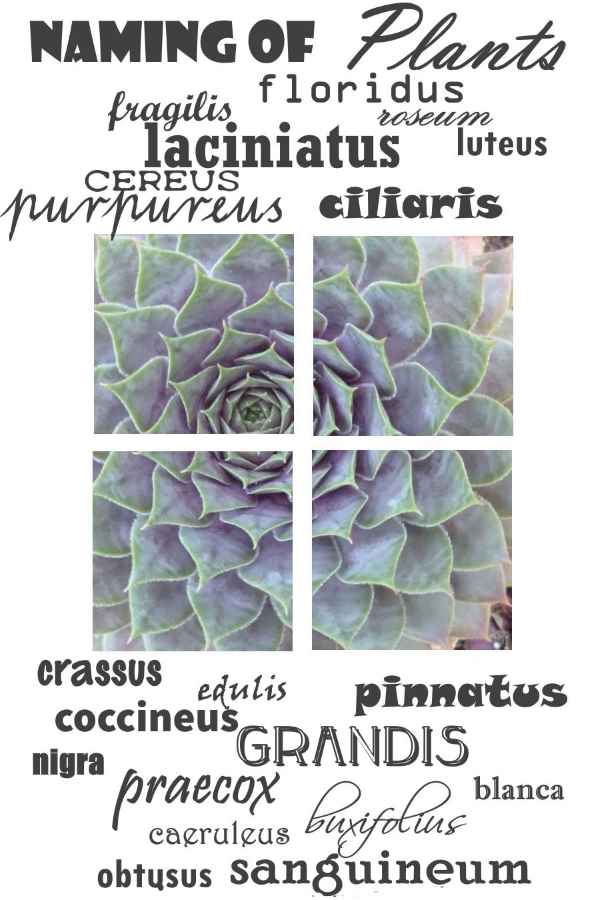Or: How Plants Get Their Tongue Twisting Latin Names
The naming of plants happens in various ways – common names of plants evolve from country folk’s fanciful descriptions of their perceived uses, or appearance.

Latin names, the correct botanical naming of plants, are based on a particular plants kinship with other similar or not so similar plants. Plant identification is based on the ways these plants relate to each other, mainly due to characteristics of blooms and leaf form and arrangement.
Some of the differences are minute and microscopic.
This leads to re-grouping plants at times into either a new genus or combining them with other genera to form a new one. The two groups of scientists and botanists responsible for this are known as ‘lumpers’ and ‘splitters’ for their preferred systems.
Using a botanical key to narrow down the possibilities will give you an idea of which genus and species your plant belongs to.
Each genus is grouped with others into a family, and also splits into different species. Binomial nomenclature, a long way of saying two names, defines to which genus and species each plant belongs.
Latin is used for the naming of plants, as it’s the same around the globe – even though common names may differ in other locations, the Latin botanical name will never alter.
Naming of plants using the correct botanical names can be descriptive, using the appearance of the plant such as fuzzy, upright or coloured; or commemorative, using the habitat, or sometimes the name of the person who first made the discovery on a plant exploration expedition.
A Guide to Botanical Descriptive Names of Plants:
Leaf Form:
acerifolia = maple like
angustifolia = slender leaves
aquifolius = spiny or prickly leaves
buxifolius, buxifolium = boxwood like leaves
ilicifolius = holly like leaves
laurifolius = leaves like laurel
parvifolius = small leaves
populifolius = leaves like poplar
salicifolia = willow like leaves
Colours of Foliage or Flowers:
Albus = white
argenteas = silvery
aureau = golden
azureus = sky blue
caesius = gray blue
caeruleus, coeruleus = dark blue
candidus = shiny pure white
canus = ashy gray or hoary
carneus = flesh coloured
cereus = waxy
citrinus = yellow
coccineus = scarlet
concolor = one colour
creceus = yellow
cruentus = bloody
discolor = two colours or separate colours
glaucus = covered with grey bloom or pruinose
incanus = gray, hoary
luteus = reddish yellow
nigra = black
purpureus = dark red or purple
rubens, ruber = red or ruddy
rufus – ruddy
Plant Shape:
adpressus = pressing against, hugging
altus = tall
arboreus = tree like
capitatus = head like
compactus = compact, densely growing
confertus = crowded, pressed together
contortus = twisted
decumbens = laying down
depressus = pressed down
elegans = elegant, slender, willowy
fastigiatus = upright, branches erect and close together
humifusus = sprawling on the ground
humilis = low, small, humble
impressus = impressed upon
nanus = dwarf
procumbens = trailing
prostrates = prostrate
pumilis = puny, insignificant
repens = creeping
reptans = creeping
scandens = climbing
Plant Characteristics:
armutus = armed
baccatus = berried or berry like
barbatus = barbed or bearded
campanulatus = bell or cup shaped
ciliaris = fringed
cordatus = heart shaped
cornutus = horned
crassus = thick or fleshy
decurrens = running down the stem
-dendron = tree
diffractans = shattering
diversi = varying
edulis = edible
floridus = free flowering
fragilis = fragile, brittle
fruticosus = shrubby
fulgens = shiny
gracilis = slender, thin or small
grandis = large and showy
-ifer, -iferus = bearing or having – for example, stoloniferus = having stolons
laciniatus = fringed or torn edges
laevigatus = smooth
lobatus = lobed
maculatus = spotted
mollis = soft, or softly haired
mucronatus = pointed
nutans = nodding or swaying
officianalis = medicinal
obtusus = blunt or flattened
-oides = like or resembling – for example – jasminoides, like a jasmine
patens = open spreading growth
pinnatus = like a feather
plenus = double, or full
plumosus = feathery
praecox = precocious, early blooming, early growing
pungens = piercing
radicans = rooting, especially along the stem
reticulatus = net veined
retusus = notched at blunt apex
rugosus = wrinkled or rough
sacharatus = sweet or sugary
sagittalis = arrow like
scabrous = rough feeling
scoparius = broom like
Geographical Locale:
The suffix –ensis which means ‘of a place’ is added to place names to specify the habitat of origin.
australis = southern
borealis = northern
campestris = of the field or plains
canadensis = of Canada
canariensis = of the Canary Islands
carpensis = of the Cape of Good Hope area
chilensis = of Chile
chinensis = of China
hortensis = of gardens
insularis = of the island
japonica = of Japan
littoralis = of the seashore
montanus = of the mountains
riparius = of river banks
rivalis, rivularis = of brooks
saxatilis = inhabiting rocks
tectorum = roof growing
You can see the root words of many words in the English language in the Latin botanical names of plants, so contrary to the belief of many scholars, Latin is not really a dead language at all, simply adapted to our use for the naming of plants.

